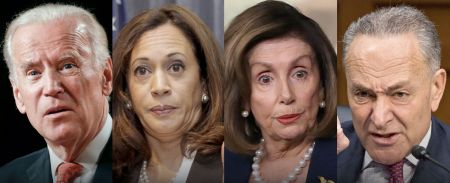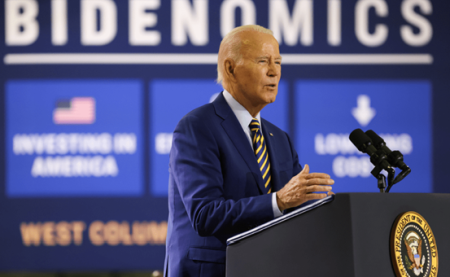Among the elite, 74% say their finances are getting better – compared with 20% of the rest of voters
Most Americans wouldn’t consider a banking titan as a spokesman for the Common Man. But give JP Morgan Chase's CEO Jamie Dimon credit for putting his pinkie finger on the phenomenon – the divide – that best explains today’s unsettled political environment. In am interview last week with CNBC, Mr. Dimon took issue with a disconnected liberal elite that scorns the nation's so-called “MAGA” voters.
“The Democrats have done a pretty good job with the ‘deplorables’ – hugging on to their bibles, their beer and their guns.
"I mean, really? Could we just stop that stuff, and actually grow up and treat other people with respect and listen to them a little bit?”
 The powerful, the intellectual, and the lazy have long said that the “divide” in this country is between rich and poor. They divvy up Americans along traditional lines related to wealth – college, no college, white-collar, blue-collar, income – then layer on other demographics.
The powerful, the intellectual, and the lazy have long said that the “divide” in this country is between rich and poor. They divvy up Americans along traditional lines related to wealth – college, no college, white-collar, blue-collar, income – then layer on other demographics.
This framing has given us the “diploma divide” and the “new suburban voter” and “Hillbilly Elegy.” It’s sent the political class scrambling to understand Donald Trump’s “forgotten man” – again, defined economically.
That framing fails to account for the country’s unsettled electorate. There’s a better description of the shifts both between and within the parties, a split that better explains changing voter demographics and growing populist sentiments. It’s the chasm between a disconnected elite and average Americans. This is becoming a them-vs.-us electorate and election. Political candidates, take heed.
This gulf is described by unique new polling from Scott Rasmussen’s RMG Research, conducted for the Committee to Unleash Prosperity.
Mr. Rasmussen says that for more than a year he’d been intrigued by consistent outlier data from a subset of Americans – which he later defined as those with a postgraduate degree, earning more than $150,000 a year, and living in a high-density area. Mr. Rasmussen in the fall conducted two surveys of these “elites” and compared their views to everyone else.
Talk about out of touch.
Among the elite, 74% say their finances are getting better, compared with 20% of the rest of voters. (The share is 88% among elites who are Ivy League graduates.)
The elite give President Biden an 84% approval rating, compared with 40% from non-elites. And their complete faith in their fellow elites extends beyond Mr. Biden. Large majorities of them have a favorable view of university professors (89%), journalists (79%), lawyers and union leaders (78%) and even members of Congress (67%).
Two-thirds say they’d prefer a candidate who said teachers and educational professionals – not parents – should decide what children are taught.
More striking is the elite view on bedrock American principles, central to the biggest political fights of today.
- Nearly 50% of elites believe the U.S. provides “too much individual freedom”
- compared with nearly 60% of voters who believe there's too much “government control”
- 77% of elites support “strict rationing of gas, meat, and electricity” to fight climate change
- vs. 28% of everyone else
 More than 2/3rds of elite Ivy graduates favor banning things like gasoline-powered cars and stoves – and inessential air travel in the name of the environment
More than 2/3rds of elite Ivy graduates favor banning things like gasoline-powered cars and stoves – and inessential air travel in the name of the environment- More than 70% of Average American Voters say they’d be unwilling to pay more than $100 a year in taxes or costs for climate
- compared with 70% of elites who said they’d pay from $250 up to “whatever it takes”
This framing explains today’s politics
While this elite is small, its members are prominent in every major institution of American power – from media to universities to government to Wall Street, and they've become more intent on imposing their agenda from above. Many American voters feel helplessly under assault from policies that ignore their situation or values.
What unites “rich” and “poor” parents in the revolt against educational failings? A common rejection of disconnected teachers unions and ivory-tower academics.
Why are growing numbers of minorities – across all incomes and education levels – rejecting Democrats? They no longer recognize a progressive movement that reflexively espouses that elite view.
Why are voters on both sides – including “free market” conservatives – gravitating to politicians who bash “big business” and trade and are increasingly isolationist? They feel the system is rigged by elites that care more about the globe than them.
And why the continued appeal of Mr. Trump? The man is a walking promise to stick it to the “establishment” (never mind that most of his party’s establishment has endorsed him).
This lack of trust and cultural divide are no healthier than the simpler rich-poor split – but they’re there.
The challenge for Mr. Trump’s GOP opponents as they move through the primaries is to recognize the sense of alienation. That doesn’t mean calling to burn everything down (Vivek Ramaswamy tried that and freaked people out), but it does require a campaign that offers more than vague promises to “strengthen the cause of freedom” or run on “your issues.”
The polling suggests that most Americans are looking for a leader who promises to return power to the people.
They are looking for a freedom agenda. Anyone?
 Kimberley Strassel is a member of The Wall Street Journal Editorial Board, who writes editorials and the Journal's weekly Potomac Watch political column as well. A regular contributor to Sunday political shows – including CBS's "Face the Nation," Fox News Sunday, and NBC's "Meet the Press," – she is the author of "The Intimidation Game: How the Left Is Silencing Free Speech."
Kimberley Strassel is a member of The Wall Street Journal Editorial Board, who writes editorials and the Journal's weekly Potomac Watch political column as well. A regular contributor to Sunday political shows – including CBS's "Face the Nation," Fox News Sunday, and NBC's "Meet the Press," – she is the author of "The Intimidation Game: How the Left Is Silencing Free Speech."























